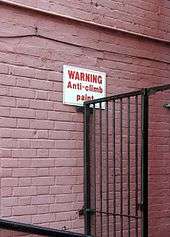Anti-climb paint


Anti-climb paint (also known as non-drying paint, anti-intruder paint, anti-vandal grease) is a class of paint consisting of a thick oily coating that is applied with a stiff brush, trowel or by hand using a protective glove. In appearance it is similar to smooth gloss paint when applied but it remains slippery indefinitely thereby preventing any intruder from gaining a foothold.
Advantage
It is used to prevent climbing on objects such as lamp posts, walls and fences. It owes its effectiveness to the fact that it is based on a non-drying oil and keeps the surface greasy and slippery. As an additional advantage, it leaves its mark on the person touching it and hence makes it possible for intruders to be identified.
Characteristics
Anti-climb paint continues to work in hot or cold weather conditions, adhering to the surfaces to which it is applied. It can be used on most building materials. It is particularly effective in preventing climbing on walls, parapets, boundary fences, down pipes, lamp standards and roofs. It has an effective lifetime of around three years, after which a fresh coat is recommended depending on local factors.
Safety
To keep the general public from being affected by the paint, it is usually applied above a certain height on the object being painted. Typically it is applied from a height of 8 ft / 2.4 metres above the ground. The paint is most effective when an intruder has to climb several feet before being stopped by a band of anti-climb paint.